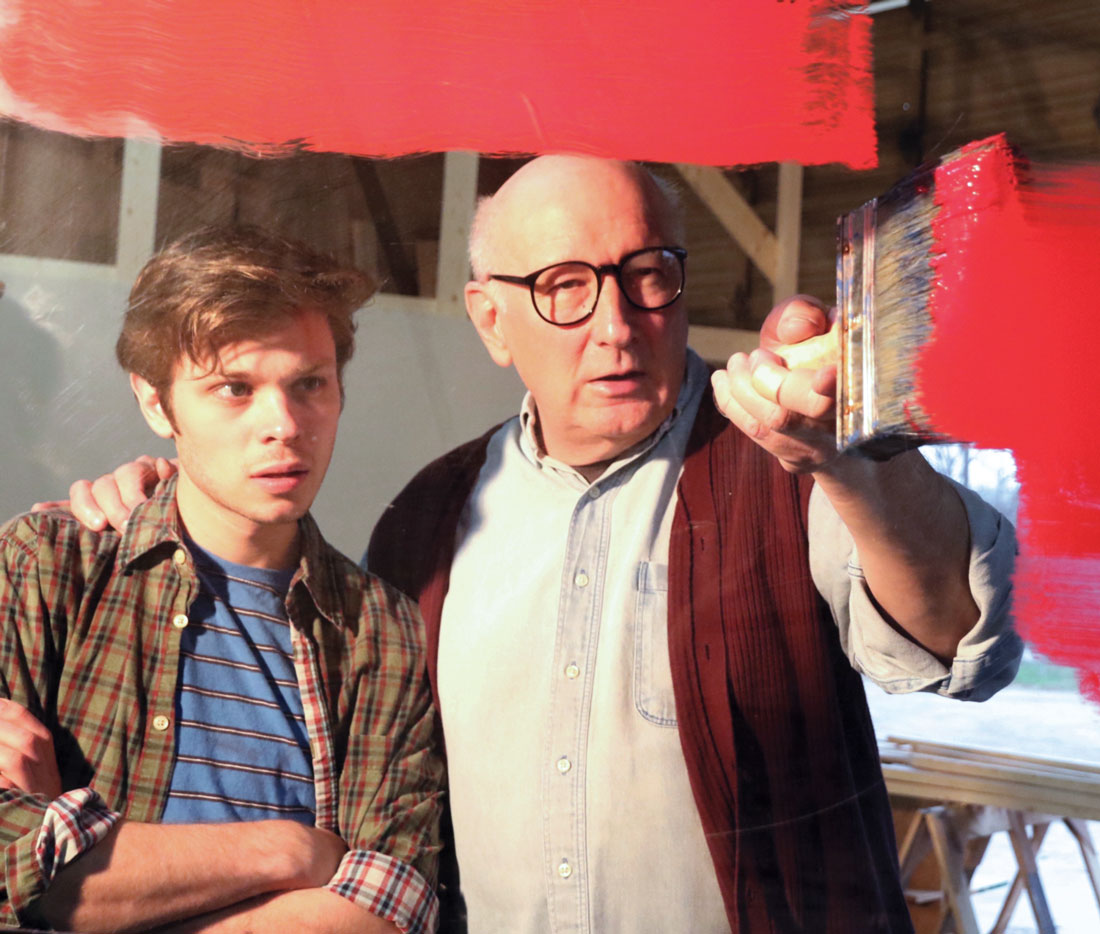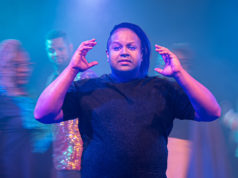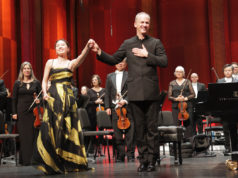Unlike, say, writers, visual artists can be illuminating to watch at work, which is why so many films and plays are about painters or sculptors. Showing an actor daub paint on canvas or carve a block of material into a sculpture is a sure way to grab an audience’s attention. What’s harder is capturing the mind-set that drives someone to do those things and guides their hands. This is particularly true of abstract-expressionist artists, who devoted much energy to maintaining the enigmatic mystique of their creations. Penetrating that is the goal of John Logan’s 2010 play Red, which plays at Stage West in a worthy, if not transporting, production.
Taking place in five installments without an intermission, the play is set in the New York City studio of Mark Rothko (Jim Covault) as he hires an assistant named Ken (Nate Davis) and works with him over the course of two years in the 1950s, after first warning the young man from Iowa that the job will not be glamorous. Devoted to painting abstract blocks of color that pulsate with movement, the artist is gearing up to paint his first-ever mural, to decorate the Four Seasons restaurant inside the new Seagram Building in Midtown.
This play is by the creator of TV’s Penny Dreadful and the screenwriter of Hollywood movies Skyfall, Rango, and Sweeney Todd. Some of Rothko’s lines here are taken directly from sources like a TV documentary interview. Logan does take some liberties with history — there was no Ken in reality, and Rothko was not an acclaimed artist but a struggling unknown when he accepted the Seagram commission from the renowned architects Philip Johnson and Mies van der Rohe. Logan invents these bits to ask rhetorical questions about an artist’s relationship with the world. Rothko prized his solitude as essential to creating, but when does solitude become insularity? When does engaging the commercial wider world become selling out? The character Rothko insists that he wants the paintings to create a space for hours’ worth of pained reflection, and Ken eventually works up the nerve to ask whether a fancy restaurant for the city’s power elite is the best venue for what he wants to achieve.
(The play omits a spooky detail: After pulling out of the Seagram commission, Rothko kept the paintings he made for the job, donating them in 1970 to London’s Tate Gallery. He killed himself on the day the Tate received them.)
Amid all of that, we do gain an inside look at the unglamorous workings of an artist’s studio, with a lengthy stretch devoted to Ken stapling a canvas to a frame while Rothko ruminates on his dead colleague Jackson Pollock. The play’s most mesmerizing moment is a bravura piece of stagecraft in the middle of the third scene, when the two men act in concert to quickly slap a ground coat of red paint onto a blank canvas. This may or may not be enough to compensate for the fact that no actual painting goes on in the play. Then again, if you’re here to see a Rothko painting take shape before your eyes, you’re in the wrong place.
Red won the Tony Award for Best New Play in 2010, but it’s not without its flaws. Rothko mocking Ken for being inexact when he uses the word “red” is good, but the following exchange, when they trade their associations with the color, runs the point into the ground. The big revelation in the third scene, when Ken discloses the family trauma that haunts his life, is a bit cheesy, too.
Maybe a better performance could have put that over, but Davis is underpowered in the role. Granted, it can’t be the easiest thing to hold the stage by oneself against an actor like Covault, but I wanted more from him in the climactic blow-up in the fourth scene, when Ken finally calls out his boss for turning into yet another middle-aged establishment figure who can’t relate to the youth of his day. It’s Covault who owns the show, exaggerating Rothko’s Eastern European accent to play a man who clings to his status as an outsider while he flirts with fame and riches. (The artist was born in Latvia but spoke English without a trace of his foreign origin.) He projects the truculence of this man at war with the contradictions of his profession and pursuing a vision of artistic purity even at the cost of his own mental health. The play concludes with the painter reaching some sort of grudging peace with his assistant and the younger generation that he represents, but we know it will be only temporary.
[box_info]Red
Thru May 10 at Stage West, 821 W Vickery Av, FW.
$30-34. 817-784-9378.[/box_info]












